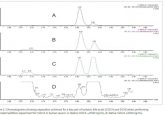Analyzing biomarkers in drug development
Author:
Weiping Shao
Vice President of Biologics Services
Frontage Laboratories, Inc. (PA, USA)As VP of Biologics Services for Frontage Laboratories, Dr Shao oversees overall operations, scientific achievement and regulatory rigor of PK/TK, immunogenicity and biomarker analysis in support of innovative biologics, biosimilars, and new therapeutic modalities including gene therapy, nucleic acid therapeutics and CAR-T cell therapy. He also oversees CLIA compliant method validation and testing, genomic services including quantitative PCR and next generation sequencing (NGS). Weiping has over 20 years of experience in pharmaceutical / biotech industry.
Biomarkers as indicators of biological and pathogenic processes have been used for decades to diagnose patients and prescribe treatment. In the past 10 years, however, they’ve substantially changed drug development practices. The demand for analyzing biomarkers in drug development has increased dramatically with the advancement of precision medicine. In the drug development context, biomarkers that are indicative of mechanism of action, target engagement and clinical outcomes have been employed to assess both the safety and efficacy of an intervention. More specifically, biomarkers have been used either to select patients for clinical trials, to make go/no-go decisions, to support registration and label claims, or to treat patients.
Key challenges
It is often the case that researchers identify a biomarker for an intended context of use (COU) [1], but there is no corresponding method available to detect its presence in tissue or other biologic matrices. Thus, an assay must be developed, qualified or even validated for the intended COU using the fit-for-purpose (FFP) approach [2].
- Growing selection of platforms and instruments. The number of platforms/instruments at our disposal to assay biomarkers continues to expand to address different testing challenges and priorities. Thus, it is ever more difficult to select the right platform for the biomarker assay. Among the most common bioanalytical platforms for measuring biomarkers today are ligand-binding assays (LBA), LC–MS, flow cytometry, immunohistochemistry and genomics assays. Ultimately, a number of factors go into deciding which methodology to use and researchers must understand both the biological question at hand and the benefits vs limitations of each platform.
- Growing complexity of assay validation. Although the intended COU determines the FFP validation, as a consensus in the industry, the critical validation parameters for biomarker assays typically include accuracy, precision, assay range (including sensitivity), parallelism, specificity, selectivity and sample stability. A good assay needs to balance sensitivity and selectivity. This is especially true for large molecules in biologic matrices. However, to date there is no harmonized global biomarker specific analysis / validation guidance. The C-Path White Paper provided the consensus document on best practice approaches, although it only addressed biomarker assay validation for singleplex LBA and immunometric assays, mass spectrometry and enzyme-based assays [3]. The appropriate qualification or validation parameters and acceptance criteria may vary based on the platforms and specific technology and some may not be applicable to the qualitative assays.
In recent years, panels of biomarkers analyzed simultaneously on multiplexing platforms have gained momentum in supporting clinical trials because of the advantage of small sample volumes and high analysis throughput. However, unique challenges have been presented when developing and validating multiplex assays. These include (1) Lot-to-lot variability, which makes it difficult to keep the assay ranges within the validated ranges for all analytes; (2) Preparation of matrix Quality Control (QC) samples because of different endogenous analyte levels; (3) Optimal assay conditions for some analytes may not work for all in the same panel; (4) Data analysis and integration with LIMS are complex; and (5) Multiplex LBAs may require additional characterization of validation parameters (not addressed in the C-Path White Paper).
- Complex and changing regulatory practices for analyzing biomarkers. Given that there is a significant increase in biomarkers used to support drug development, best regulatory practices in the laboratories for analyzing biomarkers are expected to follow. However, in the US, many differences exist between Good Laboratory Practice (GLP), Good Clinical Practice (GCP), Good Clinical Laboratory Practice (GCLP) and Clinical Laboratory Improvement Amendments (CLIA) regulations [4]. This has created challenges in deciding which regulations to follow for analyzing biomarkers. In drug development, biomarkers are typically used either for internal decision-making as exploratory endpoints, for regulatory submission (often labeled as primary / secondary endpoints in studies) under Good Practice (GxP) guidelines, or for patients and dose selection / patient’s treatment decisions, which most likely fall under CLIA. The analysis of clinical trial samples does not follow GLP regulations but should follow the concept of GCLP.
Advice for outsourcing biomarker research
Outsourcing biomarker research presents a number of challenges and selecting the right research partner is essential to the success of a complex biomarker project. The critical elements in outsourcing biomarker analysis, especially for clinical studies, includes expertise, previous experiences with the assays, platforms, regulatory experience, compliance history and communication. Although cost is one of the factors in the selection process, it should not be the deciding factor unless the biomarker analysis is exploratory in nature, and even then, it should still follow a scientifically-driven approach.
Because of the complexity of biomarker COU and FFP validation considerations, you should engage your biomarker research partner early so that the proper bioanalytical strategy can be implemented for assay development, validation and study sample analysis. It is critical that the sponsor and the partner use active communication and scientific engagement to define the FFP assay requirements and acceptance criteria based on the purpose of the biomarkers in the clinical study.
Appreciate what you don’t know, which includes determining what questions to ask of your partner or what questions will likely be asked by regulatory agencies. Sometimes companies, out of scientific interest, explore biomarkers that are not stable or are collected in the wrong matrices, delaying development time and wasting money. In other cases, developers define their biomarker research focus too narrowly, thus missing out on important biomarkers that help to address scientific questions. The right biomarker research partner can help you to determine the key questions that must be answered in the analysis.
Conclusion
A paradigm shift towards personalized medicine in healthcare has led to a surge in biomarker development and a corresponding increase in the complexities and challenges in biomarker research at every stage of drug development. The scientific stakes and regulatory expectations have been raised, and it is more critical than ever to rely on a research partner with the proper tools, facilities, experience and expertise to accelerate drug development and eventually to maximize the therapeutic efficacy and improve the safety of treatments.
References
[1] FDA-NIH Biomarker Working Group. BEST (Biomarkers, Endpoints and other Tools) Resources. Silver Spring (MD): Food and Drug Administration (US); Bethesda (MD): National Institutes of Health (US); (2016).
[2] Lee JW, Devanarayan V, Barrett YC et al. Fit-for-purpose method development and validation for successful biomarker measurement. Pharm. Res. 23(2), 312–328 (2006).
[3] Piccoli SP, Sauer JM, Baker AF et al. Points to consider document: scientific and regulatory considerations for the analytical validation of assays used in the qualification of biomarkers in biological matrices. (2019).
[4] Swanson BN. Delivery of high-quality biomarker assays. Dis. Markers. 18(2), 47–56 (2002).
The opinions expressed in this feature are those of the author and do not necessarily reflect the views of Bioanalysis Zone or Future Science Group.






